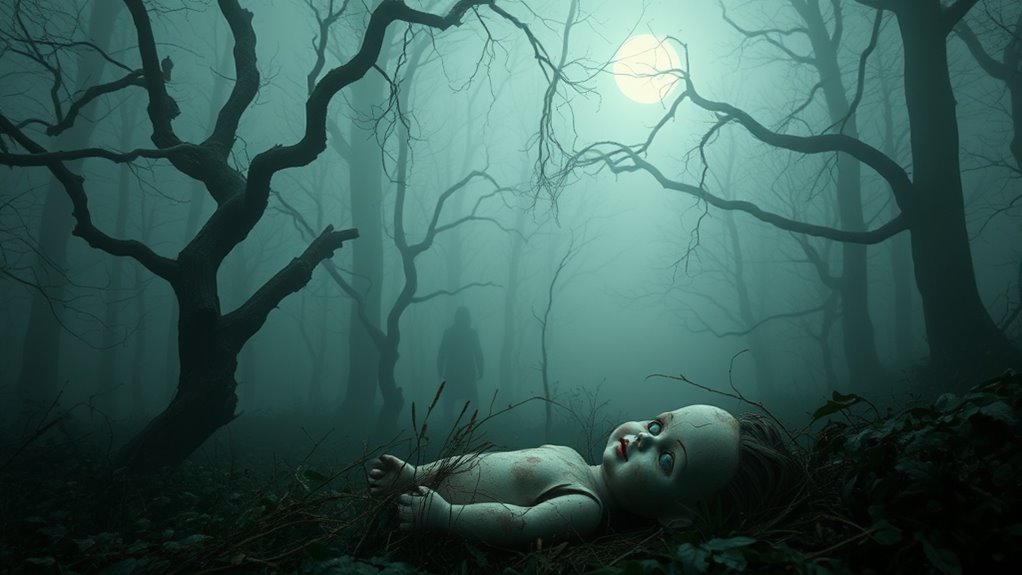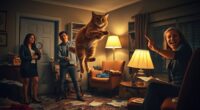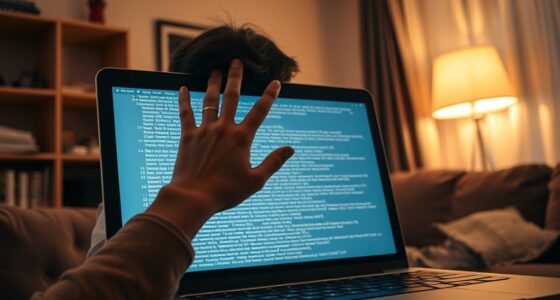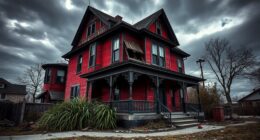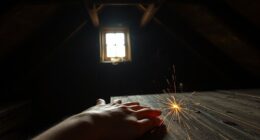Got some creepy photos? We’d love to see your unique take on body horror and unsettling natural phenomena. Capture the essence of fear through unnatural transformations or eerie visuals that chill to the bone. From iconic horror figures to real-life crime scenes, your images can evoke powerful emotions in viewers. So why not share your work and join a community that thrives on the enthralling domain of fear? There’s so much more to explore and create together!
Key Takeaways
- Capture unsettling imagery that evokes deep emotional responses, reflecting personal fears and anxieties through your photographs.
- Explore themes of body horror by showcasing unnatural transformations or grotesque subjects that challenge the viewer’s perception of reality.
- Utilize eerie natural phenomena, like mirages or light distortions, to create visually striking and creepy effects in your photos.
- Incorporate elements of cultural significance, drawing from shared fears and beliefs to enhance the creepiness of your imagery.
- Engage with online communities to share your photos and collaborate on creative storytelling, fostering a supportive atmosphere for creepy content.
Body Horror: Unnatural Transformations
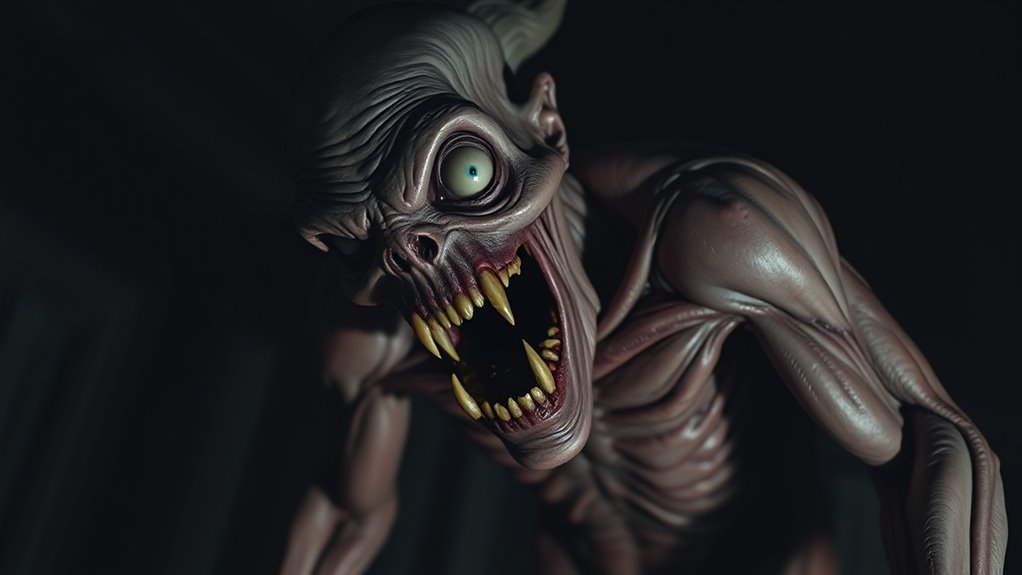
Body horror captivates audiences by exploring unnatural transformations that push the boundaries of the human form. In films like *The Fly*, you watch in horror as Seth Brundle merges with a fly, illustrating a gruesome mutation that’s hard to forget. *An American Werewolf in London* showcases Oscar-winning effects that make you feel the pain of transformation in visceral ways. The film’s transformation sequence lasts over two minutes, emphasizing the agony of becoming a werewolf. Then there’s *Akira*, where Tetsuo becomes a grotesque abomination, provoking thoughts on power and identity. Even animated features like *The Little Mermaid* reveal body horror through Ariel’s involuntary change into a polyp. Each transformation confronts you with fear and fascination, reminding you how fragile the human condition truly is, and how easily it can be distorted into something horrifying.
Nature’s Disturbing Phenomena

While the natural world often enchants us, it also harbors phenomena that can leave you feeling unsettled.
Take the Fata Morgana, where light bends to create eerie mirages that warp reality. Fata Morgana are known to distort objects, creating a surreal experience that blurs the line between fantasy and reality.
The Fata Morgana distorts perception, conjuring surreal mirages that challenge our grasp of reality.
Then there’s the Novaya Zemlya Effect, tricking you into believing the Sun rises early, adding to the strangeness of polar landscapes.
Light pillars shoot from the clouds, casting an otherworldly glow, while ice halos form haunting rings around the Sun.
And don’t forget about Blood Falls in Antarctica, where red water flows like a sinister stream.
The Sailing Stones of Death Valley move mysteriously across the desert floor, and the unsettling currents of Bolton Strid lure you closer, whispering myths of those who’ve vanished in its depths.
Themes of Entrapment and Desperation
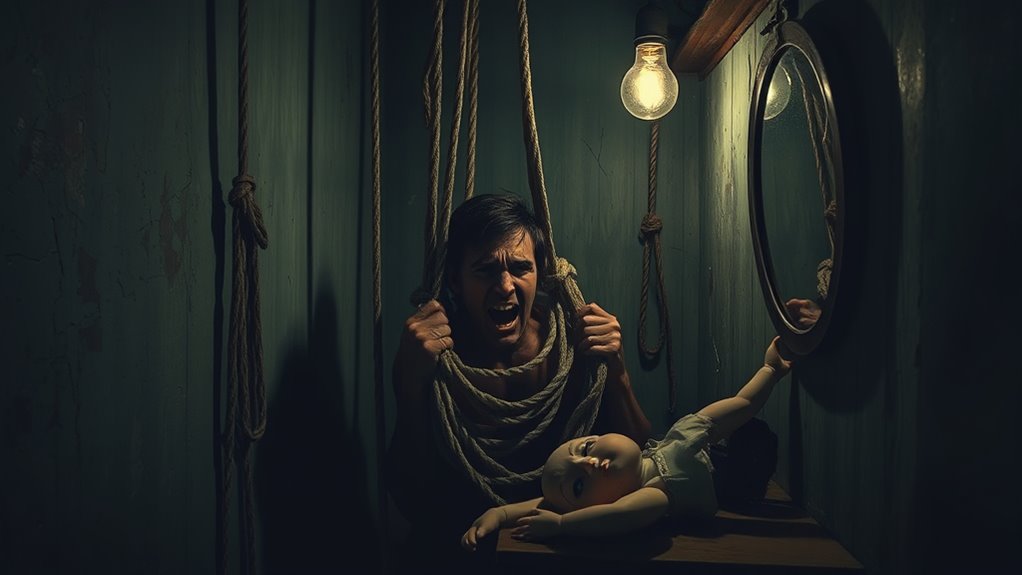
Themes of entrapment and desperation often resonate deeply within art, capturing the emotional struggles that many face in their lives. You might find images where characters appear confined in oppressive settings, evoking feelings of anxiety and claustrophobia.
Visual metaphors like doorways, webs, and cages highlight this sense of entrapment, allowing artists to express their personal fears. Techniques such as strategic lighting and character portrayal enhance the isolation depicted in these works. Artists like Gregory Crewdson and Samantha explore these themes, inviting you to connect with their narratives. Ultimately, these pieces reflect societal pressures and encourage viewers to contemplate their own limitations, fostering empathy and understanding through shared experiences of confinement and desperation. Notably, the casting process employed by artists allows for a unique exploration of the human condition within these confined spaces. This exploration intersects with art theory, enriching the narrative by providing context on how emotional struggles are represented in visual forms.
Iconic Figures From Horror Pop Culture
Art can capture deep emotional struggles, but horror pop culture gives life to iconic figures that embody our darkest fears. Characters like Michael Myers and Freddy Krueger haunt our nightmares, with Myers’ chilling mask and Krueger’s deadly glove etching themselves into our minds.
Jason Voorhees stalks Camp Crystal Lake, while Ripley from *Alien* proves that strength can emerge from chaos. The Babadook symbolizes grief, and Black Phillip introduces us to dark witchcraft. Jason Voorhees’ signature hockey mask adds a chilling element to his character, making him a defining figure in the slasher genre.
Jason Voorhees haunts Camp Crystal Lake, while Ripley emerges as a beacon of strength amid chaos.
M3GAN blends technology with terror, while Pennywise reminds us of childhood fears. Each villain, from Candyman’s tragic tale to Leatherface’s horrifying legacy, leaves an indelible mark.
These figures don’t just scare us; they reflect our deepest anxieties, making them unforgettable icons in horror pop culture.
True Crime: Real-Life Horror Scenes
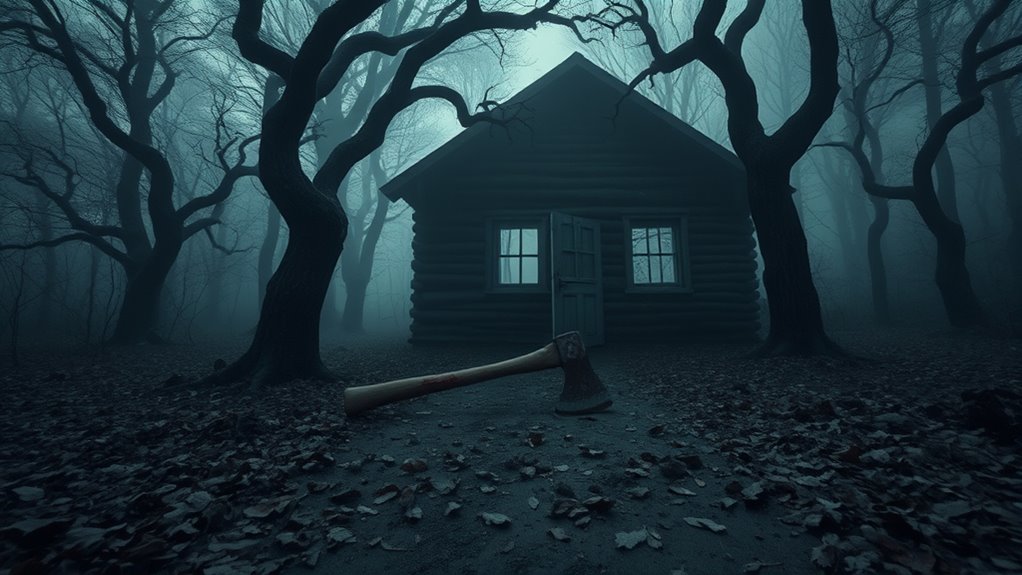
True crime immerses you in chilling realities that often feel stranger than fiction, revealing the darkest corners of human nature.
Take the Travis Alexander murder, where Jodi Arias committed her horrific act in his own home. The case echoes the disturbing nature of the Forchan Murder, where a shocking crime was revealed through anonymous online posts, leading to the arrest of the perpetrator.
Then there’s Gary Heidnik, whose basement became a nightmarish prison for his victims. The BTK Killer sent letters taunting authorities while targeting families in their own spaces, leaving communities in fear.
Elisa Lam’s unsettling disappearance from a hotel adds another layer of mystery, while Kennedy Ife’s exorcism gone wrong illustrates the terrifying extremes of belief.
Each case, with its grim backdrop, forces you to confront the unsettling truth that real-life horror can be more terrifying than any film.
Hyperreal Scenarios: The Uncanny Valley

As technology advances, you might find yourself confronted with the unsettling phenomenon known as the uncanny valley. This concept, introduced by Masahiro Mori in 1970, describes how human-like objects that are almost realistic evoke eeriness or revulsion.
You may notice this effect in robotics, CGI, and lifelike dolls, especially when they move. The ambiguity of these almost-but-not-quite human features triggers emotional dissonance, leaving you feeling uneasy. Unsettling feeling is often observed when encountering eerily human-like objects.
Films like *Final Fantasy: Spirits Within* and *The Polar Express* showcase characters that fall into this uncanny valley, often perceived as cold or soulless.
Designers must tread carefully, considering facial expressions and movements to avoid this unsettling reaction, ensuring their creations resonate positively rather than creepily.
The Psychological Effects of Creepy Imagery

While you might feel a rush of fear when confronted with creepy imagery, this experience triggers complex psychological responses that can be both unsettling and enlightening.
Exposure to such images can heighten your anxiety, especially if you’re naturally sensitive. However, confronting these fears in a controlled setting can also build emotional resilience. The brain’s immediate response to fear is fight-or-flight, which prepares your body for action and enhances your awareness of surroundings.
Confronting fears in a safe environment can enhance emotional strength, even as anxiety may initially rise.
As you process the initial shock, your brain releases dopamine, leading to feelings of relief and pleasure. Engaging with creepy content also taps into collective fears, fostering a sense of shared experience with others.
Ultimately, this journey through fear can help refine your coping mechanisms and provide valuable insights into mortality and the human condition, all while keeping you safely distanced from the threat.
Artistic Interpretations of Fear and Horror
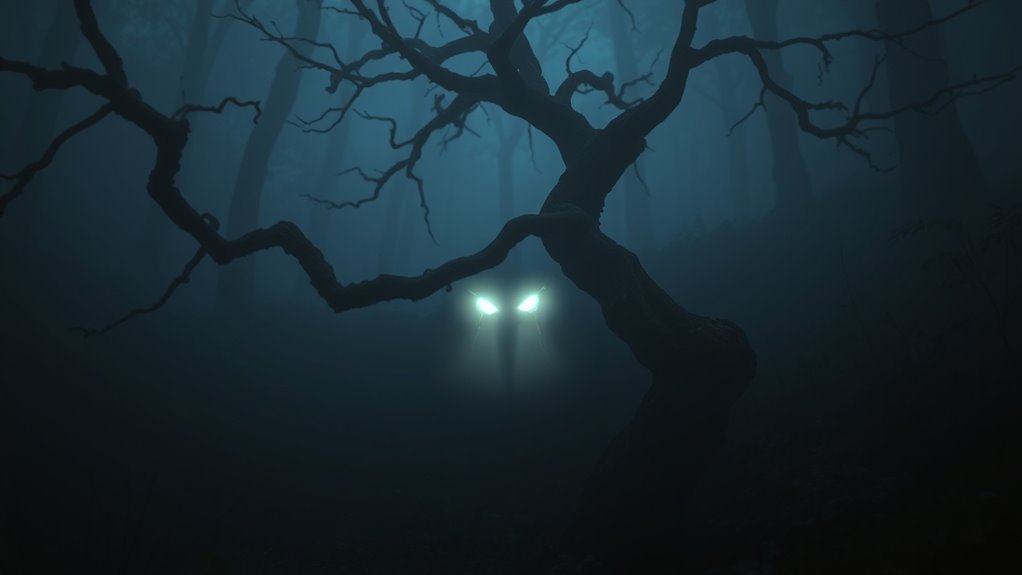
Artistic interpretations of fear and horror capture the essence of our deepest anxieties, inviting you to confront what lurks beneath the surface of your mind. Distorted anatomy and ghastly facial expressions create unsettling images that emphasize vulnerability and the monstrous. Atmosphere sets the stage for fear by incorporating dark shadows and lighting, enhancing the overall impact of the artwork. Metaphorical representations and psychological imagery tap into primal fears, allowing you to explore nightmares and phobias. Body language, too, communicates terror without words, enhancing emotional engagement. Historical masterpieces like Bosch’s and Goya’s paintings reveal how artists have long investigated dark themes, evoking unease through graphic and haunting visuals. These artistic techniques not only stimulate aesthetic appreciation but also provoke introspection, making horror art a powerful medium for exploring the complexities of fear and the human experience. Understanding narcissistic tendencies can also illuminate the darker aspects of human behavior reflected in horror art.
Cultural Significance of Creepy Visuals
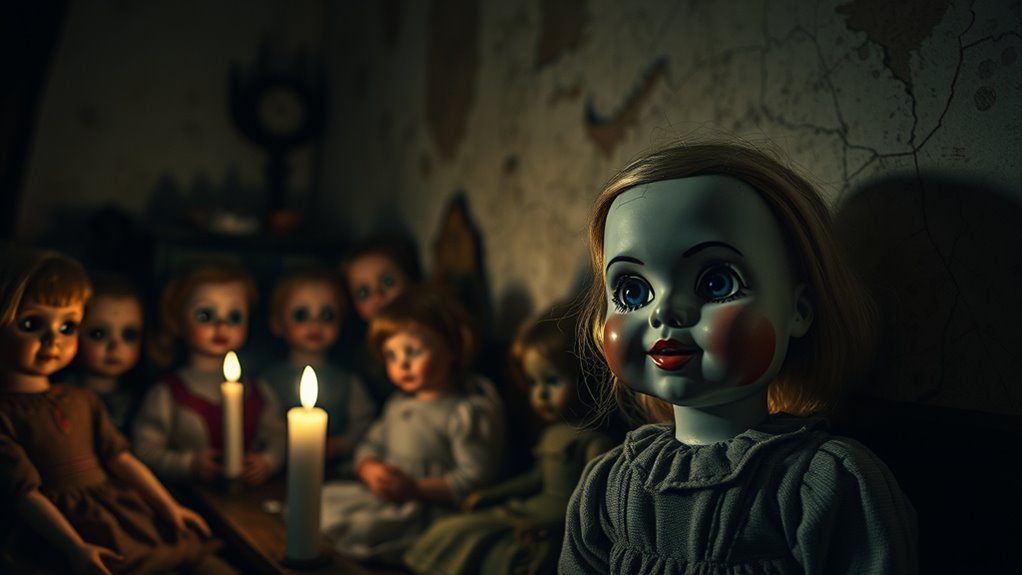
Creepy visuals resonate deeply across cultures, reflecting shared fears and beliefs that transcend time and geography. You’ll find that throughout history, art has captured unsettling imagery, revealing societal anxieties.
From medieval grotesques to folklore-inspired legends, these visuals serve specific functions, often rooted in cultural significance. They evoke strong emotional responses, providing both adrenaline rushes and a sense of escapism. Horror serves as an unexpected yet persistent presence in life, allowing individuals to confront their fears through art.
Ritualistic practices, like sky burials or initiation rites, might seem eerie, but they reflect deep respect for nature and the supernatural. Even contemporary media, like creepypastas, tap into this fascination, creating cultural icons that symbolize our collective fears.
Ultimately, what you find creepy can vary, highlighting the richness of cultural context in shaping our perceptions.
Engaging With Online Communities of the Creepy
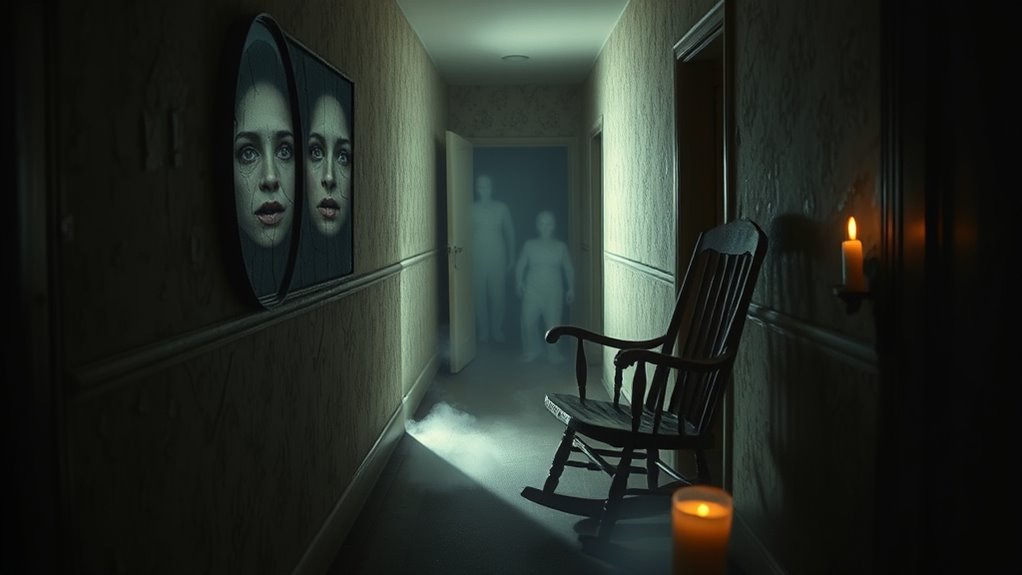
As you plunge into the world of online communities centered around eerie storytelling, you’ll discover a vibrant tapestry of creativity and collaboration. Creepypasta’s origins on forums like 4chan and Something Awful fostered a unique space for users to craft spine-chilling narratives together. Characters like Slender Man and Jeff the Killer emerged from this shared imagination, blurring the lines between fiction and reality. The Creepypasta Wiki serves as a treasure trove of these haunting tales, reflecting the genre’s influence on digital horror culture. Additionally, these communities thrive on collective input, allowing users to contribute alternate endings and expand existing lore. This collaborative spirit mirrors the principles of utilitarian thinkers who advocate for actions that maximize overall well-being. However, maneuvering through these communities can be tricky, as negative interactions like trolling may arise. Engaging meaningfully involves embracing the creativity while setting boundaries, ensuring a supportive atmosphere for all fans of the creepy.
Frequently Asked Questions
What Types of Photos Are Considered Creepy?
When you think about creepy photos, several types come to mind. Tragic family portraits captured before disasters can send chills down your spine.
Post-mortem photography from the Victorian era evokes an unsettling feeling. You might also find unsettling medical images, like autopsy photos, quite eerie.
Additionally, pictures of ghostly figures or mysterious creatures spark curiosity and fear. Abandoned locations can also have that creepy vibe, leaving you feeling uneasy about what lurks in the shadows.
How Do I Submit My Creepy Photos?
To submit your creepy photos, first choose a platform that aligns with your theme, like CreepyStock or Shutterstock.
Make sure your images meet their quality standards. Next, create an account and follow their submission guidelines, which typically involve uploading your photos directly.
Don’t forget to check the copyright terms to understand your rights. Once you’ve submitted, engage with the community to boost your visibility and receive feedback on your work.
Are There Any Restrictions on Submitted Content?
When you’re submitting content, consider vital constraints.
Content can’t contain violence, nudity, or any inappropriate imagery. You’ve gotta own the photos, guaranteeing you respect legal rights and permissions.
Additionally, keep your images authentic; avoid alterations and AI-generated elements. Compliance with platform policies is key, too.
Will My Submitted Photos Be Credited?
Yes, your submitted photos will be credited. When you share your images, it’s essential to guarantee proper attribution.
We’ll clearly display your name or handle alongside your photos, following our publication’s style guidelines. If you have specific credit requests, just let’s know.
Can I Remain Anonymous When Submitting Photos?
Absolutely, you can stay anonymous when submitting photos!
Many platforms prioritize privacy, allowing you to upload without revealing your identity. By choosing services that emphasize encryption and anonymous sharing, you guarantee your submissions remain secure and confidential.
Just remember to check the site’s policies to confirm they support anonymous uploads.
Conclusion
So, whether you’re drawn to body horror or the unsettling beauty of nature’s oddities, creepy imagery resonates with many. Did you know that over 60% of people report feeling a thrill when looking at eerie pictures? This fascination isn’t just about fear; it’s about exploring the unknown. So, as you sift through your collections, remember that your creepiest photos might just connect you with a community that thrives on the chilling and bizarre. Share them with us!
